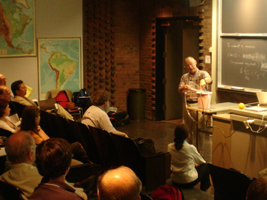Workshop: summary
Day 2: Curriculum Development
Scott Kittelman's talk addressed key tools for in-class experiments related to climate and weather. Through his talk, the difference between an experiment and a demonstration became clear – the simpler the better. Some simple experiments were suggested. For example, latent heat could be demonstrated by using hand warmers. Another example was to use spin up and spin down rotating tank experiments, pick one aspect, and explain that. Finally, he detailed the specifics needed to do these demonstrations, which were proportional to class size. The list included: NTSC video connection to projector, DVD player, computer and internet access, and a student response system. The details of constructing a mobile rotating table were outlined. The importance of lighting was discussed and the preference for fiber optics was presented. The audience suggested some cheaper alternatives: a slide projector, or a laser pointer directed through a glass stirring rod. Another suggestion for successful demonstrations was adaptable data acquisition software. Scott suggested Labview. Videos can be used to show additional experiments which may take more time than available during the class, but which are worth showing. However, there is no substitute for seeing the lab experiments and demonstrations in person.
Jack Whitehead spoke about experiments in geology and geophysics. Since his experience was mostly teaching to graduate students, his experiments were a little more technical. However, the first few examples were simple enough for undergraduates. First, he described how to demonstrate the Rayleigh-Taylor instability. Using a rectangular box filled with glycerin or corn syrup, and a thin layer at the surface of oil that is clamped shut, wavelength selection can be readily observed when the apparatus is turned upside down.  Next, he presented a demonstration of a plume using pipes, corn syrup, and watered-down corn syrup (~1-2% water). The injected watered-down corn syrup can’t ascend in the denser corn syrup until it has grown into a big enough sphere. An additional experiment can be done modifying the plume experiment by placing it on a sloping bottom. The next experiment he showed involved pumping melted paraffin over a cooled aluminum plate. This experiment showed how flow was focused in response to the phase change. As the paraffin cooled and solidified, the molten paraffin veered into another direction, clockwise around the plate. He also presented a solitary wave collision, which was published in Nature (1986), an unsteady volcano experiment, salt channelization, and an earthquake machine. Finally, the talk was concluded with a demo about subcritical and supercritical Froude number flows.
Next, he presented a demonstration of a plume using pipes, corn syrup, and watered-down corn syrup (~1-2% water). The injected watered-down corn syrup can’t ascend in the denser corn syrup until it has grown into a big enough sphere. An additional experiment can be done modifying the plume experiment by placing it on a sloping bottom. The next experiment he showed involved pumping melted paraffin over a cooled aluminum plate. This experiment showed how flow was focused in response to the phase change. As the paraffin cooled and solidified, the molten paraffin veered into another direction, clockwise around the plate. He also presented a solitary wave collision, which was published in Nature (1986), an unsteady volcano experiment, salt channelization, and an earthquake machine. Finally, the talk was concluded with a demo about subcritical and supercritical Froude number flows.
Joe Witte offered views of a broadcast meteorologist. His goal was to get input on demonstrations that meteorologists could use to teach the public about greenhouse gas emissions into the atmosphere. An approach was presented where the CO2 from a car was totaled up and estimates were given as to how high the car would fill up the atmosphere with CO2. A problem with atmospheric visualizations is that the atmosphere is much thinner than the public perceives it to be from currently available visualizations. In addition, questions were raised as to how to demonstrate the dispersion of CO2 in the atmosphere. A lively discussion of simple models for the greenhouse effect for the public followed this talk. The idea that the greenhouse may not be the best example of the effect CO2 has on global temperature was raised. A solution was suggested to cut up the radiation balance problem into smaller pieces. In particular, to do a demo of absorption of light by gases, maybe even use one that phosphoresces – absorbs the visible light and then glows with the lights out – as an analog for CO2 and infared light.